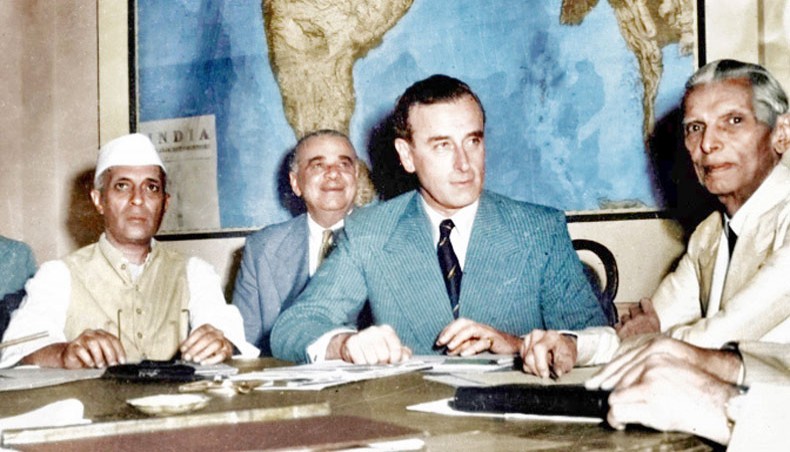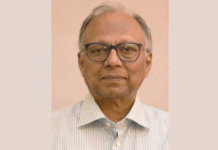Are we ‘strangers’ to our own history?
M Rashiduzzaman | 7 October 2022

From right to left, Muhammad Ali Jinnah, Lord Mountbatten and Pandit Nehru discuss partition of India 1946. — Deadline/Getty Images
NOW, 75 years since a divided India gained freedom in 1947, prime minister Modi’s surging juggernaut of Hindutva has cast a pall of gloom over the subcontinent. The old Hindu-Muslim conflict that catapulted India into the controversial division has resurfaced in public discourses all over the world. At present, a fresh dialogue looms large over what really happened long ago and what were the seismic forces that led India to the contentious split into two states. More than an academic debate, those underlying forces of the past are strategically relevant to peaceful living of the subcontinent’s people now and in the future. What I am offering here are a few slices of the ‘missing narratives’ of the past with a focus on the division of Bengal and its subsequent configurations in East Pakistan/Bangladesh.
Members of my village community, I recall, introduced themselves as Muslim, Hindu and Christian. Identity inspiration was still transient when half of old Bengal (East Bengal/East Pakistan) became Pakistan’s east wing and the other half of Bengal transformed into India’s new West Bengal province by the middle of August 1947. Between those two parts of Bengal, all that mattered for the people was their religion and geography — those two attributes determined their future, location, and national identity.
Objectively, the 1947 Partition narrative goes beyond the unhappy recounts of the refugees and multitudes of those who lost their lives, and those who suffered injuries and became homeless. To an extent, the years between the two world wars, unfortunately an overlooked historical ground, foretold what happened to Bengal in 1947 and what later transpired in East Pakistan in 1971. A simmering distrust and discontent prevailed between the Hindus and the Muslims in Bengal since the termination of the 1905 division of the province. The rise of the Muslim League in 1906 was a disagreement with the Indian National Congress’s trajectory against the creation of a Muslim-majority East Bengal province in 1905.
During the inter-war years, the expanded electorate and the new-fangled quasi-parliamentary institutions turned the table by empowering the Muslims in Bengal and other Muslim-majority provinces. Neither the Congress Party nor the Hindu elite liked the legislative ascendancy of the Muslims in Bengal politics. Forgetting, marginalising, or repudiating those phenomena in the milieu of that division is a decapitation of the history of Bangladesh and the Indian part of Bengal. Such missing chronicles have indeed made many of us ‘strangers’ to our own history.
Both Nirad C Chaudhury and Joya Chatterjee in The Autobiography of an Unknown Indian and Bengal Divided: Hindu Communalism and the Partition 1932–1947 respectively made ground-breaking observations about the old Bengal politics. An astute observer of the united Bengal’s Muslim politics, Abul Mansur Ahmed’s Amar Dekha Rajnitiir Panchasbachar fills up the gaps of scholarly studies of the period. Nirad weighed up the Hindu elite’s fears of the gradual Muslim ascendancy in politics in the 20th-century Bengal. The growing Hindu-Muslim tension in the 1920s and 1930s that escalated in the 1940s was the focus of Joya Chatterjee’s research. Tajul Islam Hashmi’s Pakistan: As a Peasant Utopia: The Communalization of Class Struggle in East Bengal 1920-1947, explained how the Pakistan fever trailblazed into a dreamland of the overwhelmingly Muslim peasants in East Bengal. In my own micro study Identity of A Muslim Family in Colonial Bengal: Between Memories and History, the grass roots echoed the All-Bengal Hindu-Muslim rivalries.
Owing to historical and social reasons, the Muslim community in colonial Bengal fell behind higher education and in different professions. But, on the other hand, the educationally advanced minority Hindu bhadralok in East Bengal enjoyed the lion’s share in local administration, schools, health, and trade and, in the moneylending and rent-receiving landed classes too. Only a few aspiring Muslims went to school and later competed for government jobs and patronage. By 1940s, the pro-Pakistan stump gained unprecedented political traction among the Muslims in Bengal as they saw the impending wilt of the exploitative landed gentry and increased educational and employment opportunities in the expected new Muslim-majority state.
Best part of the well-educated West Bengali Muslims who moved to East Pakistan after the 1947 division usually received comparable and even better jobs and promotions in Pakistan. The professed Bihari Muslims migrated to different areas of East Pakistan after severe communal rioting in those districts of Bihar that were close to East Pakistan borders. Numerous of them were factory and mine workers; they found fewer job opportunities in the rural areas. Brimming stories about the East Bengali Hindu refugees wrestling for survival in India are hard to ignore. Bangladesh or earlier East Pakistan, on the other hand, had scarce accounts of the Muslim refugees fleeing from India and the circumstances that forced them out of the country. On my watch, I came across only one recount of a well-known writer who fled to Dhaka under harrowing conditions. A couple of my cousins lived in Kolkata — when they returned after the partition, they felt that they were ‘driven out of Kolkata.’ Without the experiences of the West Bengali/Bihari Muslims fleeing to Pakistan, the refugee details of the 1947 partition remained inchoate.
Two elderly unmarried teachers at our school explained to my father in 1947 that they had virtually nowhere else to go. Our school clerk, a scion of a Talukdar family, suddenly disappeared to India. A few of the locally prominent Hindu families were amongst the first who left for India. By mid 1940s, instead of Hindu bhadralok running the elected village councils, school managing committees, co-operative bodies, voluntary services, and small business outlets in the past, the fresh faces, mostly Muslims, took over the local outfits. It was a loss of power for the Hindu elites and the perceived fear of the Muslim majority in East Pakistan exhorted them to leave. Once the privileged Hindus left from the neighbouring villages, the less advantaged Hindus also did not stay behind for long. Except occasional Dhaka-centred stabbings, scattered arsons and the infamous anti-Hindu bloodshed in Noakhali, I did not hear about any massive killings in East Pakistan in the 1940s and the 1950s.
Often forgotten now — a good deal of the contemporary Bangladeshi (Muslim) middle class began their trek in colonial Bengal as education and job opportunities slowly expanded. My father recollected that from the 1920s to the 1940s, most young and educated people, with the meritorious exceptions, got jobs through backings of the prestigious feudal families and the rising politicians and government officials. He observed that the Muslim job seekers went to their Muslim sponsors and the Hindus got support from the influential Hindu patrons. Bulk of the struggling Muslim middle class of the East Bengal districts got a lift in East Pakistan while the inter wing disparities also clouded Pakistan’s political horizon.
Notwithstanding the liberal/secular reservations about the 1947 division of Bengal, East Pakistan did not turn into an abode of Islamic zealotry, but it failed to stop the dribbling Hindu minority flight. Most independence campaigners and the Awami League-led exiled government in India were liberal and secular in their orientations in 1971. And yet, Bangladesh, a separate state since 1971, did not reunite with the rest of Bengal by merging with India. Pakistan’s two-nation theory suffered a setback in 1971, but the Bangladeshi borders are still those inspired by the communal division — the foreign umpires hurriedly midwifed it in 1947. East Pakistan’s nascent middle class unquestionably prospered even more in current Bangladesh; in recent years, the minority representation in government jobs in Bangladesh increased significantly. Ironically, the roots of those beneficiaries are in the blaze of the 1947 Partition — acknowledged or rejected.
While Bangladesh continues as a Muslim-majority state under the 1947-defined borders, the partition remains the old wound especially among those Hindus from East Pakistan/Bangladesh who left their hearth and home because of that division. Compared with what happened in East Bengal/East Pakistan, the flight between the West Pakistani and Indian border was much bloodier and more painful in the earlier post-1947 years.
Nationalistic, partisan and patriotic hyperboles cannot change the historical facts. Meanwhile, more knowledge about Bangladesh in its previous configurations and awareness of who got what in pre-1947 Bengal and in post-1947 East Pakistan/Bangladesh will save us from the historical amnesia. More importantly, it will protect us from the tragedy of ‘falsified history’, as Badruddin Umar warned in his The Emergecne of Bangladesh.
M Rashiduzzaman is a retired academic. This article partly draws from his Identity of a Muslim Family in Colonial Bengal: Between Memories and History, Peter Lang, 2021, NYC and Parties and Politics in Former East Pakistan: Political Inheritances of Bangladesh (publication expected in 2023).
The article was published in the New Age Bangladesh









